Lyudmila Alexandrovna Smirnova
Lesson outline(middle group) on this topic
« Winter walk oh»
Program content
1. Continue to introduce children to the properties of snow (cold, white, crispy)
2. Exercise in walking with a wide and small step, in a snake, in a circle, holding hands, in inventing movements.
3. Play by following the rules of the game. Choose a driver using a rhyme.
4. Develop speed and dexterity of movements, orientation in space.
5. To cultivate attention, caring attitude towards birds, the desire to participate in joint labor activities.
Remote material: skittles, ribbons, shoulder blades, bells, snowman's hat, cap.
caregiver: How much snow everywhere! (Offers to touch it with hands)
What snow?
Children: Cold. Do conclusion: you do not need to take it with your hands, but you must wear mittens. In cold weather, the snow is not sticky, it crumbles. Let's all walk in the snow. What do you hear?
Children: The snow crunches underfoot.
Teacher with children pronounce: One step, two steps, snow crunches under the foot.
caregiver Why does snow crunch underfoot? (children's answers)
Together they draw a conclusion: Snow consists of small snowflakes, they are very fragile. When we step on the snow, the snowflakes break and crunch.
caregiver: Lots of snow, nowhere to run.
There is also snow on the paths.
Here, guys, shovels for you -
Will work for everyone!
Today we will clear the paths to the veranda, this will be done by Serezha and Artem (instruction to use a shovel)
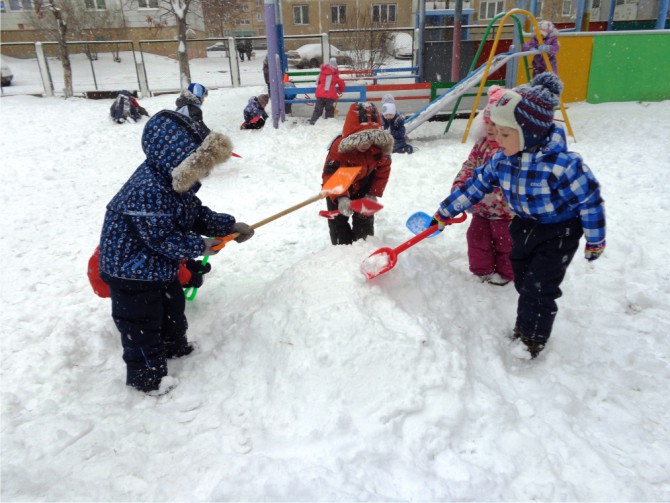
Maxim V. will clear the path to the feeder, and the rest of the guys will go with me to clean the snow on the site (Daniel Kira, Mark, Matvey, Albina, Nikita, Daniel) During work, the teacher tells poetry:
Quietly, quietly it snows
White snow, shaggy.
We'll clear the snow and ice
In the yard with a shovel.
caregiver: Well done, everyone worked hard, put the blades in the snow. What is the most important thing we need to do? (leads the children to the feeder)
Children: What poem did we compose so that the birds would fly faster? Who will tell? (the teacher puts a piece of bread to the child, he, holding out his hand to the feeder, loudly He speaks:
Birdie, birdie come
And fly into the feeder
Here are some crumbs for you
On my palm.
The teacher helps put the bread in the feeder and He speaks: And now it's time for us to play, kids.
The game we are about to play is called "Trap, take the tape"
Children stand in a circle and use a counter to choose a trap.
One, two, three, four, five.
We decided to play
Suddenly a crow flew
And I told you to drive.
The teacher helps all children, except for the trap, to lay a colored ribbon for a belt or collar.
The trap stands in the center of the circle. At the signal of the driver "Run!" children run around the playground. The trap catches up with them, trying to pull the ribbon from someone. The one who has lost the ribbon temporarily steps aside. After the words educator: One, two, three, quickly run into a circle! the children gather in a circle. The trap counts the number of ribbons and returns them to the children. The game restarts with a new trap.

caregiver: And now the gnomes and giants will walk a little along the winding path (Puts pins at a distance of 1 m from the other. On a signal "Giants" The children are walking at a great pace. On signal "Gnomes" children walk slowly (3 p.)
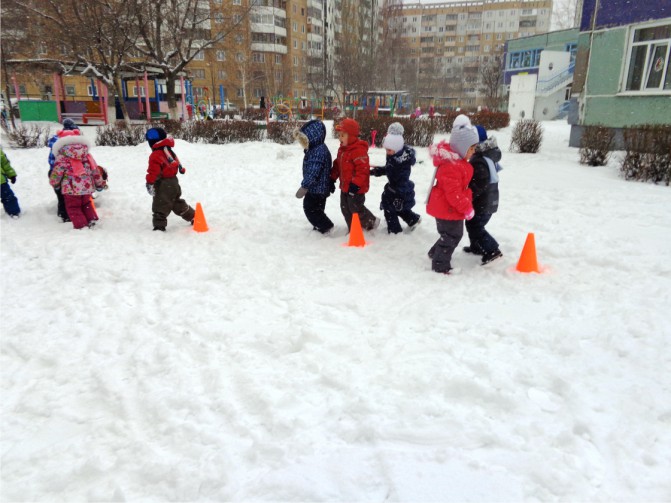
caregiver: Let's go in a circle one after another, hey guys, don't yawn, what Danilka will show us, we will do it exactly. The child, whose name is called by the leader, goes to the middle of the circle and shows his movement.
Children repeat (4r.)
caregiver: And now "Cap-snowman"
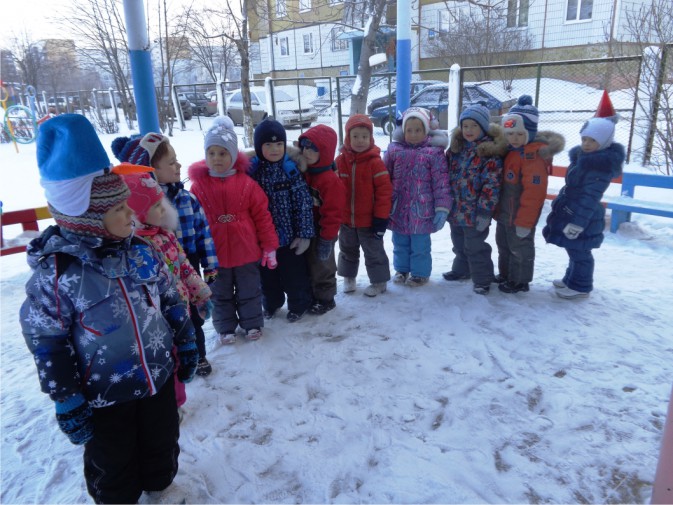
Children become one after another. A snowman's hat is put on the first child, and a cap on the last. At the signal of the teacher "Snowman"- children go in a column, behind a snowman. On signal "Cap", the children turn one after another in the opposite direction and follow "Cap"(4r.)
caregiver: Now play whatever you want, as you wish.
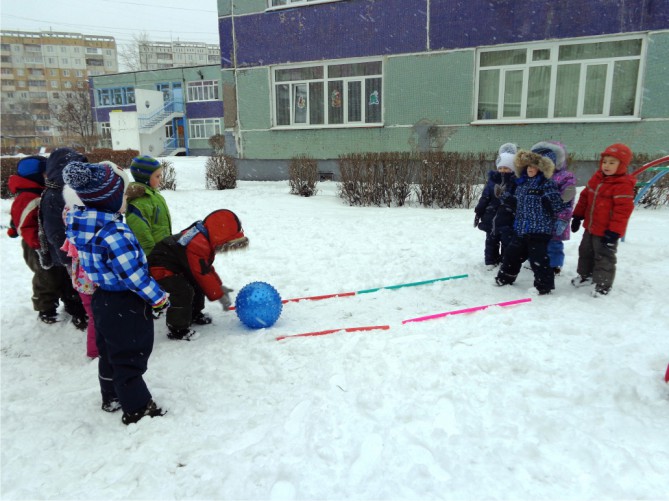
Individual work with Maxim. "Step over the ice bumps"
Related publications:
Lesson summary for middle group on the topic "A dog is a man's friend." Subject: A dog is man's best friend. Purpose: - the formation of ideas in children.
Purpose: to introduce children to various forms of expressing a request addressed to someone ( close person, stranger, peer) in different.
Abstract of a lesson on the development of speech for children of the middle group "Walk in the forest" Purpose: consolidation of the material covered on the topic "Wild Animals". Educational tasks: 1. Continue to acquaint children with the inhabitants of the forest.
The summary of the lesson on ecology for the middle group was prepared by: Lagoida Natalya Sergeevna, educator of MBDOU No. 4 "Rosinka", Tikhoretsk, Krasnodar.
Summary of classes with children of the middle group "Walking around the city" Goal: Organize cognitive activity children to consolidate knowledge of street names, addresses kindergarten, school buildings, shop,.
Priority area of the Federal State Educational Standard: speech development Tasks: Correctional and educational: - to form in children the ability to form possessive.
Outline of a physical education lesson for children of the middle group Date: August Venue: Krasnoyarsk Time: 20 minutes Equipment and inventory: balls according to the number of children, 2 racks, cord.
Lesson outline
Svetlana Jalilova
target walk"Winter at the kindergarten" (middle group) .
caregiver: Dzhalilova Svetlana Shakulievna.
Integration of educational regions: "Knowledge", "Communication", "Socialization",
Kinds children's activities: playful, communicative, cognitive-research,
physical.
1. To consolidate children's knowledge of winter natural phenomena. Show the children the bird feeder. To form a desire to feed the birds in winter, to help the birds to winter. Expand children's ideas about wintering birds.
2. Equipment, materials. Feeder made by the hands of parents and children. Bird food.
3. Connection with other occupations and activities. Observations for. birds flying to plot. Bird feeding. Mobile game "Sparrows and a cat
Walk progress:
Educator. Guys, what's the weather like today? How is it different from autumn? (Children's answers.) Listen riddle:
Snow on the fields
Ice on the rivers
Blizzard walks -
When does it happen?
What season is the riddle about? That's right, guys, about winter. Listen to a poem about winter.
White snow fluffy
Spinning in the air
And the earth is quiet
Falling, laying down.
And in the morning with snow
The field is white
Like a veil
All dressed him up.
Dark forest with a hat
Covered up wonderful
And fell asleep under her
Strongly, imperceptibly.
I. Surikov
“A beautiful poem, isn't it? Let's take a closer look at the first white snowflakes as they swirl, slowly sinking to the ground. Let's compete to see who gets the most snowflakes on their mittens!
If you catch a snowflake in the palm of your hand, what will happen? (Children make sure that snowflakes melt quickly). This is because snow is made up of water. In autumn, instead of snow, it rains, and in winter, from frost, the raindrops freeze and turn into snowflakes.
Now try with your palm, what kind of snow does it feel like? That's right, cold.
But for the earth and plants, snow is a real warm blanket. How more in winter snow, the warmer grasses, shrubs. Snow protects them from severe frosts and balls. Let's see how plants sleep under a white fluffy blanket. (The teacher carefully rakes the snow to the ground and shows the children green blades of grass.) And when spring comes, the snow will melt, and the grass will turn green and grow again.
Let's go ahead and see what happened to our trees. Do they have leaves? (Children's answers.) That's right, guys, the trees are bare, there is not a single leaf. Tell me, is there a tree that does not change its outfit in autumn and winter?
Winter and summer in one color.
- What is it? That's right, tree. All winter the Christmas tree is green, it is not afraid of frost, instead of leaves it has beautiful green needles. Very soon the green Christmas tree will come to us for the holiday. Guess which one? That's right, in winter, all people celebrate the New Year.
And here is our feeder. Let's put food in it, the birds will fly and thank us for it. Remember why birds need to be fed in winter. (children's answers).
The teacher invites the children to play the game "Sparrows and a cat".
Sparrow children stand along the edge of the playground. Sitting on the other side "cat", the role of which is played by one of the guys. "Sparrows flew", says the educator
"Sparrows jump off the roof and spread their wings (stretching arms out to the sides). Waving them, running all over the place plot. "Cat" sleeping. But then she wakes up, says "Meow meow" and scares sparrows. "Sparrows" scatter.
The game is repeated 2-3 times.
In the end walks teacher along with children conclude that that has come winter winter became even colder than autumn. Leaves fell from the trees, snow fell.
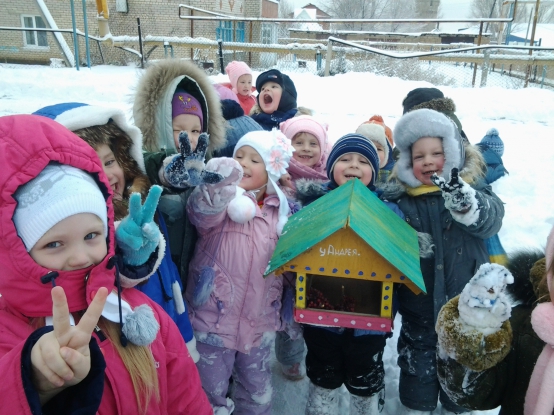 "Winter fun"
abstract winter walk in the middle group
"Winter fun"
abstract winter walk in the middle group
Educational area: "Cognitive Development"
Integration educational areas: « Speech development”, “Cognitive development”, “ Physical development”, “Social and communicative development”.
Type of: integrated.
Children's age: 4-5 years.
Forms educational activities: group.
Target: continue to acquaint with the phenomena of nature.Encourage children to actively use the acquired skills in performing various sports exercises and games.ATto cultivate positive attitudes towards collective activity, to work, to healthy lifestyle life, friendliness,purposefulness, observation, curiosity. Draw children's attention to the beauty of nature.
Preliminary work: reading poetry, guessing riddles, looking at plot pictures about winter.
Equipment and material: shovels for snow removal on the site, molds, sleds, sleds.
Structure of the walk:
Artistic word - 2 min.
Observation of snow and snowflakes - 10 min.
Experience with snow - 5 min.
Outdoor game: "Snow and ice" - 15 min.
Didactic game: "What happens in winter?" - 6 min.
Labor activity - 15 min.
Sedentary game: "Don't wake up the bear" - 10 min.
Individual work - 10 min.
Independent play activity of children - 40 min.
Outcome - 2 min.
Walk progress:
Educator: Guys, listen to the poem.
Where are the snowflakes from?
Who knits snowflakes and throws them from the sky?
Even mom doesn't know patterns like that
And the yarn has never been seen like this -
Our city is all white, slightly blue. Or maybe they are cut out of calico
And quietly lowered to my eyelashes?
Tears on the cheeks, they slowly melt ...
Where are the snowflakes from? Does anyone know?
Watching snow, snowflakes.
Educator: What season is this poem about?
Children: Winter.
Educator: That's right, guys, about winter. Nice poem, right? Can you tell me what's in the air?
Children: Snowflakes.
Educator: Guys, let's take a close look at the white snowflakes, how they spin and slowly and smoothly fall to the ground. Let's stretch the handles forward and see whose mitten gets more snowflakes!
Snow experience.
A snowflake fell into my palm,
I will warm her with my breath a little.
Snowflake, have you decided to play hide and seek?
I can't see you in my palm.
Educator: What do you think, if you catch a snowflake in the palm of your hand, what will happen? (Children catch snowflakes on their bare hands and make sure that the snowflakes melt quickly).
Children: She melted.
Educator: Yes, they melt because snow is water. In winter it is cold, frost and raindrops freeze and turn into snowflakes. And what kind of snow, touch it with your palm?
Children (touch the snow): Cold.
Educator: Yes, the snow is cold for us. But for plants and soil, it serves as a blanket. When there is a lot of snow, the plants and soil are warmer. Now let's play a game"Snow and Ice" . Mobile game: "Snow and Ice" . Rules of the game: The leader is chosen. He turns away and says "snow» , at this time, all the players run, jump, have fun. Then the driver says the word"ice",at this time, everyone should immediately “fall asleep” (freeze in those positions in which they were at that time). The driver at this moment turns around, and the player who does not move is chosen by the driver. The game is repeated 4-5 times.Didactic game: "What happens in winter?" Educator: What happens in winter?Children: Wind, blizzard, blizzard, snowfall, snow, snowflakes.Educator: That's right guys. Look - how much snow has fallen on our site. Let's take the shovels and transform our site - remove all the snow.Labor activity: snow removal on the site (group).(Children carry snow to a certain place and make a pile of snow).
Educator: Well done boys. And let's play some more. First, guess the riddle:
Clumsy and furry,
He warms his paws in the lair.
Likes to go for a walk in summer
And protect the animals.
And in winter, under a blizzard howl,
He sleeps in a snow hut. Who is this? Children: Bear. Educator: Our game is called: "Don't wake the bear" Sedentary game: "Don't wake the bear!". Rules of the game: Children form a circle, holding hands. In a round dance they go in a circle with a teacher who pronounces the text. Like snow on the hill, snow and under the hill snow, snow. (Turn to reverse side, go in a round dance.) And under the tree snow, snow, And on the tree snow, snow. (They go to the center of the circle.) And under the tree, the bear is sleeping. Hush hush! Don't wake up, sit down, don't make noise! (They squat down.)
Individual work on the development of movements with Kirill Semenov and Yulia Akhmadieva - practice jumping on two legs with advancement forward at a distance of 2 - 3 m. The walk ends with free games for children with portable sports equipment(free play activity of children). Educator: Guys, this is the end of our walk. It's time for us to get together.Conversation with children. Educator: What games did we play today?Children's answers.- What did you like today on a walk?Children's answers. Why are we watching today? Children's answers.(Together with the children, conclude that winter has come. In winter it became cold and snow fell. Snow is water and a lot of snowflakes.).Educator: Guys, now, we put ourselves in order, brush ourselves off, collect toys, tools and go to the group.
Fedorova Anastasia Sergeevna,
educator
Kindergarten "Skazka"
"Child Development Center - Kindergarten "Firefly"
Outline of a walk using different shapes motor activity for children of the middle group
Theme: Riddles of winter
Integration of educational areas: "Cognitive development", "Speech development", "Social and communicative development", "Physical development".
Purpose: Development of cognitive activity of children in the process of forming ideas about winter, through cognitive research activities.
- expand children's ideas about winter changes in nature;
- to form primary research and cognitive interest through experimentation with ice.
- bring up careful attitude to nature;
- develop the ability to listen to a story;
- to consolidate the ability to solve a riddle;
- activate the child's vocabulary;
- to teach the logical use of figurative words and expressions in independent statements.
- exercise in the ability to alternate walking with small and wide steps;
- practice precision in sports game Snow Basketball.
Methods and techniques:
Practical: physical education session “We will warm up a little”, participation in experiments, games with elements of sports (“Snow basketball”).
Visual: viewing images in illustrations, experiments, experimenting with ice.
Verbal: answers to the questions of the teacher, listening to the story, solving the riddle.
Materials and equipment: "package from Zimushka - Winter", pieces of ice, mnemonic table, pictures with the image of: Santa Claus with the Snow Maiden, a glass, colored squares and ice cubes, lemon and drops of water; shovels, buckets, scoops, hoops.
Walk progress:
Educator: Oh, children, what is this in our area? Around everything became white, and trees and bushes, unprecedented beauty. Come closer and see the beauty...
Postman Pechkin: Wait, wait, you have a letter! (gives away)
Educator: - From whom is this letter? (reads address)
Zavodoukovsk, Kindergarten "Skazka", middle group No. 7 "Fidgets"
From "Zimushki - Zima"
I wonder what she wrote to you?
"Winter sent you a letter
In snowflakes - stars it is.
It's time for us to meet friends
You can't do without me.
You can't ride a sleigh
You can't make a snowman
Well how do you guys stay
No snow slide, no ice rink!
I am white winter
And I have a riddle.
Quickly guess it
Learn about my miracles.
Educator: Guys, solve the riddle and see the answer.
Snowball, sparkling, spinning,
And everything is white.
Lakes, rivers, puddles
Suddenly they became like glass. (Ice)
(A basket with pieces of ice appears in front of the children from the parcel).
Educator: - The ice floes are so beautiful, shiny and probably delicious. Can you eat them?
Ice cubes should not be taken by mouth. The ice is cold, you can catch a cold.
Winter is a real sorceress, turning water into sparkling pebbles. Zimushka invites us to learn the properties of ice.
Let's go to our table. Now, I will give each of you a piece of ice.
Experience No.-1
If we hold it in the palm of our hand, we can feel it. What is he? (cold)
That's right, let's denote this phenomenon with a picture - Grandfather Frost and the Snow Maiden, because they come to us only when the cold comes ...
Experience #2
The next property that we can find out is soft, brittle or hard? What do you think, what kind of ice? Let's check, try to squeeze it with our fingers. Do you think it's soft or hard? (solid)
I specifically froze these pieces of ice thinner, if I drop it now, do you think it will break or not? (fragile)
Now, let's check? What happened to the ice? (crashed, broken, splintered)
Let's denote this property of ice, so as not to forget. Look at the picture of a glass cup. It is strong, solid, if we drop it, what can happen? With this picture, we denote the second property of ice - brittleness.

Experience No. 3
Look at the ice, what color do you think it is? (colorless, white, gray)
To find out, multi-colored circles will help us. Choose one square in the color you like. Place it in the palm of your hand, colored side up, and place a piece of ice on top. Now what color is the ice?
Let's label this property. This will help us picture with the image of colored squares.
Experience No. 4
Guys, how do you think, how can you find out if the ice has a smell or not. That's right, but in order to compare its smell with another, I suggest smelling not only ice, I also prepared a lemon for you. Therefore, each of you will first sniff your piece of ice, then the cut lemon. Do you think ice has a smell?
Let's denote this property with a picture of a lemon.
Educator: Oh, something we completely froze from such magic of Zimushka-winter, and if we don’t get warm now, then very soon we will turn into the same ice
Low mobility logarithmic game "Winter Dance".
Children become in a circle, sing and show movements according to the meaning of the song:
We warm up a little
We clap our hands.
Clap! (10 times) - Children clap their hands
We put on gloves
We are not afraid of blizzards.
Yes! (10 times) - Make movements that imitate
putting on gloves
We will also warm the legs,
We'll jump faster.
Jump! (10 times) - Jump easily
We made friends with frost
How the snowflakes swirled.
So! (10 times) - Spin in place.
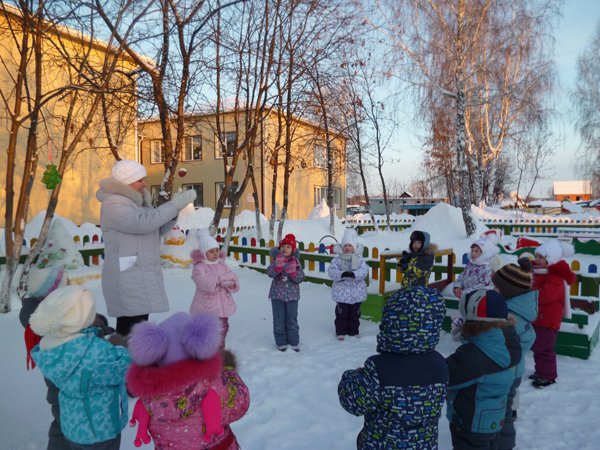
Educator:
Experience No. 5
We learned so much about the properties of ice, but while we were playing, my piece of ice disappeared somewhere. And your? (melted, turned into water)
Let's denote this property of ice as well, denote it by drops of water.
Guys, do you think this water can be turned back into ice? Can it be frozen? What is needed for this? Where can we freeze it?

Did you enjoy playing with ice? Let's remember all the properties of ice that we have considered today. The pictures that we marked during the experiments will help us with this.
(The teacher invites the children to use the algorithm to answer the questions: What kind of ice? - Cold, fragile, transparent, odorless, melts in warmth.)
So we have solved one of the mysteries of Zimushka-Zima, I think that she still has a lot of them, and she will definitely continue to acquaint us with her magic.
Now let's play the game "Snow and Ice".
Mobile game: "Snow and ice". Rules of the game: The leader is chosen. He turns away and says "snow » , at this time all the players run - jump - have fun. Then the driver pronounces the word “ice”, at this time everyone should immediately “fall asleep” (freeze in those poses in which they were at that time). The driver at this moment turns around, and the player who does not move is chosen by the driver. The game is repeated 4-5 times.
Didactic game: "What happens in winter?"
Teacher: What happens in winter?
Children: Wind, blizzard, blizzard, snowfall, snow, snowflakes.
Teacher: That's right guys. Look how much snow has fallen on our site. These are all the pranks of Zimushka - Winter. We will take shovels and transform our site - we will remove all the snow.
Labor activity: snow removal on the site (group). (Children carry snow to a certain place and make a pile of snow to create a snow fortress).
Educator: Well done guys. The job is done, now you can play. First, guess the riddle:
Who glazed all the puddles,
Covered the lake with glass
Allowed on skating rinks
Skate? (freezing)
Mobile game "Two Frosts".
Riddle: Clubfoot and furry,
He warms his paws in the lair.
Likes to go for a walk in summer
And protect the animals.
And in winter, under a blizzard howl,
Sleeping in a snow hut. Who is this?
Children: Bear.
Educator: Our game is called: "Don't Wake the Bear"
Sedentary game: "Don't wake up the bear!"
Individual work on the development of movements - exercise in the ability to alternate walking with small and wide steps, the game "Giants and Lilliputians";
Exercise in accuracy in a sports game " Snow basketball.
The walk ends with free games of children with portable sports equipment (free play activity of children).
Educator: Guys, our walk is over. It's time for us to get together.
Conversation with children:
Teacher: What games did we play today? Children's answers.
What did you like about walking today? Children's answers.
Educator: Guys, now, we put ourselves in order, dust ourselves off, collect toys, tools and go to the group.
BIBLIOGRAPHY
2. We play, walk, develop. / A.N. Ionova. - M .: Publishing house "Exam", 2010
3. Photos from the archive of the Kindergarten "Skazka", a branch of an autonomous institution preschool education Municipal Formation "Center for Child Development - Kindergarten "Svetlyachok"
We invite teachers of preschool education of the Tyumen region, Yamalo-Nenets Autonomous Okrug and Khanty-Mansi Autonomous Okrug-Yugra to publish their methodical material:
- Pedagogical experience, author's programs, teaching aids, presentations for classes, electronic games;
- Personally developed notes and scenarios of educational activities, projects, master classes (including video), forms of work with families and teachers.
Why is it profitable to publish with us?
